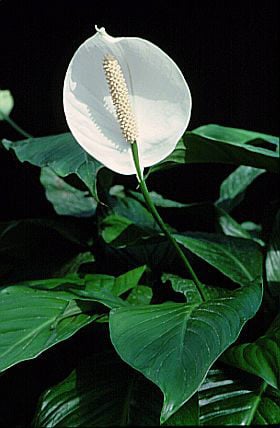Size
Ultimate height
0.5–1 metresTime to ultimate height
5–10 yearsUltimate spread
0.1–0.5 metresGrowing conditions
Moisture
Moist but well–drainedpH
Acid, Alkaline, NeutralColour & scent
| Stem | Flower | Foliage | Fruit | |
| Spring | Green | |||
|---|---|---|---|---|
| Summer | Green | |||
| Autumn | Green | |||
| Winter | Green |
Position
- Partial shade
Aspect
South–facing or East–facing
Exposure
Sheltered Hardiness
H1BBotanical details
- Family
- Araceae
- Native to GB / Ireland
- No
- Foliage
- Evergreen
- Habit
- Clump forming
- Potentially harmful
- Harmful if eaten, skin/eye irritant. Wear gloves and other protective equipment when handling Pets: Harmful if eaten, skin/eye irritant - for further information and contact numbers regarding pets, see the HTA guide to potentially harmful plants
- Genus
Spathiphyllum are evergreen rhizomatous perennials with lance-shaped leaves and tiny white flowers borne in a dense spike within an ovate, white, hood-like spathe
- Name status
Accepted
How to grow
Cultivation
Under glass grow in peat-free compost. During growth, water and mist freely; maintain a high humidity. Apply a balanced liquid fertiliser monthly. Pot on when root growth has overfilled the container. Suitable as a houseplant. See Spathiphyllum and houseplant cultivation for further advice
Propagation
Propagate by seed sown at 23-27°C when ripe or in spring. Propagate by division in winter or immediately after flowering
Suggested planting locations and garden types
- Patio and container plants
Pruning
No pruning required
Pests
Generally pest-free
Diseases
Generally disease-free
Get involved
The Royal Horticultural Society is the UK’s leading gardening charity. We aim to enrich everyone’s life through plants, and make the UK a greener and more beautiful place.
